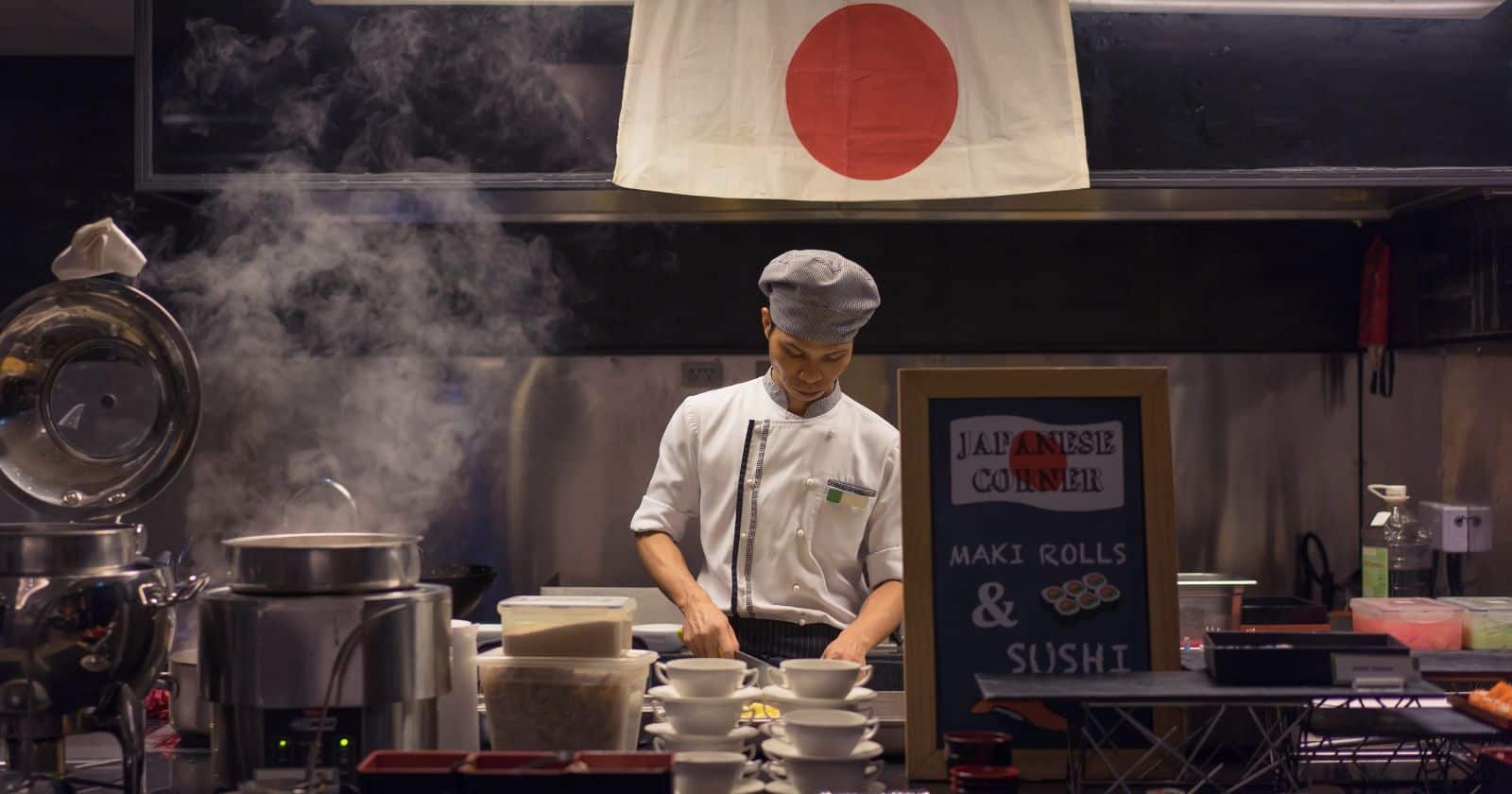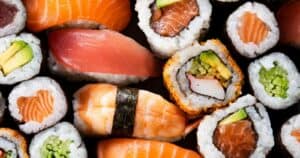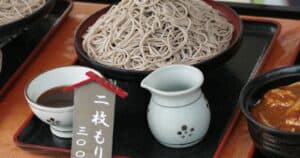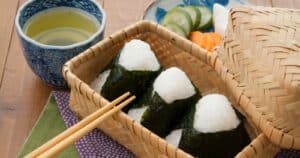When it comes to the cost of Japanese food, it’s important to consider the type of dish, the restaurant, and the location. A la carte dishes typically range from 600 to 800 yen, while sushi sets can start from 2,000 yen for lunch and go up to 10,000 yen for dinner. For a quick meal, fast-food options like McDonald’s or Burger King can cost around 700 yen.
On average, meals in Japan can cost approximately 3,670 yen per day, with most individual lunches priced at around 1,450 yen. Fine dining experiences can range from 10,000 to 20,000 yen for a three-course meal.
Alternatively, convenience stores offer more affordable options, with regular meals starting at 1,000 yen and small sandwiches at 200 yen.
For those seeking a more lavish dining experience, our following section will unveil the cultural significance of high-end restaurants in Japan. We’ll explore the concept of omakase, where skilled chefs select the menu for you, and delve into the world of kaiseki, a multi-course feast showcasing seasonal ingredients.
Factors Affecting the Cost of Japanese Food
The cost of Japanese food can vary depending on several factors. Here are some key factors that affect the cost:
- Region: One significant factor is the region in Japan. Food prices tend to be higher in major cities like Tokyo compared to other parts of the country. This is because urban areas often have higher living costs and a greater demand for food, leading to increased prices.
- Type of cuisine: The cost of Japanese food can also vary depending on the type of cuisine. High-end options like sushi and kaiseki dinners are generally more expensive due to the use of premium ingredients and skilled craftsmanship. On the other hand, street food and snacks are usually more affordable.
- Grocery shopping: Another factor affecting food costs in Japan is grocery shopping. The cost of groceries can vary depending on the origin of the products. Japan’s declining food self-sufficiency rate has led to increased reliance on food imports, which can impact the prices of groceries. Imported goods often incur additional costs like tariffs and transportation fees.
- Consumer preferences: Japanese consumers’ preferences play a role in the cost of Japanese food. Affordability and local production are key factors that drive purchasing choices. However, younger generations are increasingly favoring Western cuisine and habits, which can lead to changes in the types and amounts of food consumed. This shift in demand can affect pricing.
- Economic factors: Economic factors like high oil prices, global supply chain disruptions, and public debt can also impact the cost of Japanese food. These external factors can affect the overall costs of production, transportation, and distribution, which can eventually translate into increased prices for consumers.
Range of Prices for Popular Japanese Dishes
Sushi:
- Prices range from 2,000 yen to 10,000 yen per person.
- Conveyor-belt sushi (kaiten zushi) is the cheapest option, costing 1,000 to 2,500 yen per person for lunch or dinner.
Ramen:
- A bowl of ramen typically costs around 1,000 yen.
Udon or soba noodles:
- A bowl of soba or udon noodles costs around 600 yen.
Teppanyaki:
- Teppanyaki, which is food cooked on an iron griddle, costs between 6,000 and 10,000 yen for dinner.
Curry rice:
- Curry rice is priced around 800 yen.
Okonomiyaki:
- Okonomiyaki costs around 800 yen.
Yakitori:
- Yakitori, grilled skewered chicken, is priced at approximately 200 yen per skewer.
Tonkatsu:
- Tonkatsu, a breaded and fried pork cutlet, costs around 1,000 yen.
Bento box:
- A bento box typically costs between 500 and 1,000 yen.
Convenience store food:
- Prices for convenience store food can vary, with a small sandwich costing around 200 yen and a prepared meal with seasoned meat and rice priced at about 500 yen.
Cost of Eating at a Traditional Japanese Restaurant
The cost of eating at a traditional Japanese restaurant can vary depending on the type of establishment and the meal. On average, a meal at an average restaurant or cafe in Japan can cost around 1000-1500 yen (~$10-15 USD) . However, prices can be much higher at fine dining establishments, especially those serving continental cuisine.
For instance, at a sushi restaurant, lunch prices typically range from 2,000 to 3,000 yen for a set that includes various types of sashimi and rolled sushi. Dinner prices, on the other hand, can be around 5,000 to 10,000 yen . It’s essential to note that these prices can vary depending on the quality and reputation of the restaurant.
Moreover, for an exquisite dining experience at high-end Japanese restaurants, customers can expect to pay significantly more. Fine dining establishments can charge anywhere from 10,000 to 20,000 yen for a three-course meal for one person, especially if they specialize in serving continental cuisine .
In general, while a regular meal at a traditional Japanese restaurant can cost around 1,000 yen (~$10), prices can increase based on the restaurant’s ambiance and reputation . It’s important to consider these factors when planning a dining experience in Japan.
Budget-Friendly Options for Japanese Food Lovers
If you’re a Japanese food lover on a budget, don’t worry! There are plenty of affordable options that still deliver delicious flavors. Here are some wallet-friendly choices for you to enjoy:
- Conveyor belt sushi, or kaiten zushi, is a popular and affordable option. With prices ranging from 1,000 to 2,500 yen per person for lunch or dinner, you can satisfy your sushi cravings without breaking the bank.
- Ramen is another budget-friendly dish that you can find all over Japan. A bowl of ramen typically costs around 1,000 yen, making it a filling and affordable option.
- Gyoza, a type of Japanese dumpling, is a cheap and tasty choice. You can enjoy a plate of six gyoza for around 300 yen, making it an excellent side dish or appetizer.
- Yoshinoya is a fast-food chain that specializes in gyudon, a dish of beef and rice. A bowl at Yoshinoya will cost you between 300 to 500 yen.
- Curry rice, a popular Japanese dish, can be found in various restaurants and fast-food chains. You can expect to pay around 800 yen for a serving.
- Teppanyaki, food cooked on an iron griddle, can be a bit pricier for dinner, with prices ranging from 6,000 to 10,000 yen. However, lunch options are usually more budget-friendly.
- Convenience stores in Japan offer affordable food options. You can find sandwiches for about 200 yen and prepared meals, such as seasoned meat with rice, for around 500 yen.
- Bento boxes, a convenient and popular lunch option, can be found for around 500 to 1,000 yen.
- There are several affordable restaurant chains in Japan, such as Coco’s, Sukiya, Sushiro, and Matsuya, offering a variety of Japanese dishes at reasonable prices.
Remember, prices may vary depending on the location and restaurant, so be sure to check the specific costs at your desired dining spot. But with these budget-friendly options, you can indulge in your love for Japanese food without breaking the bank. Enjoy your delicious and affordable meals!
Premium Japanese Cuisine and its Price Range
Premium Japanese cuisine is known for its exquisite flavors and high-quality ingredients, but it often comes with a hefty price tag. Prices for a three-course meal at upscale Japanese restaurants can range from 10,000 to 20,000 yen (about $90-$180 USD) or even higher . Here’s a closer look at some examples of high-end Japanese dishes and their price ranges:
- High-end sushi: If you’re looking to experience the best sushi in Tokyo, be prepared to spend around $200-$300 per person . The price reflects not only the skilled craftsmanship of the sushi chef but also the use of top-grade ingredients such as fresh fish and premium rice.
- Wagyu beef: Renowned for its marbling and tenderness, wagyu beef is considered a delicacy in Japan. High-quality cuts can be quite expensive, with prices often exceeding $100 USD for a full assortment of samples . The cost is justified by the meticulous care given to raising and feeding the cattle, resulting in exceptionally flavorful and tender meat.
- Kaiseki: Kaiseki is a traditional multi-course Japanese dinner that showcases the chef’s artistic skills and seasonal ingredients. Prices for kaiseki meals typically start at around 10,000 JPY per person, but it’s advisable to budget for at least 15,000 JPY per person to truly indulge in this gastronomic experience . The precise preparation and presentation of each course contribute to the higher price range.
In contrast, dining at a local eatery or fast food chain in Japan can be significantly more affordable, with prices ranging from 500 to 1,000 yen (approximately $5-$10 USD) . However, it’s important to note that the quality and sophistication of the cuisine will vary compared to premium Japanese restaurants.
Cost of Sushi and Sashimi in Japanese Restaurants
The cost of sushi and sashimi in Japanese restaurants can vary depending on factors such as the type of restaurant and the meal.
On average, lunch at a sushi restaurant will cost around 2,000 to 3,000 yen for a set consisting of different sashimi and rolled sushi. For dinner at a sushi restaurant, you can expect to pay approximately 5,000 to 10,000 yen.
If you’re looking for a more affordable option, conveyor-belt sushi, or kaiten zushi, typically costs anywhere from 1,000 to 2,500 yen per person for lunch or dinner.
If you’re looking to indulge in high-end sushi, be prepared to spend around US $200 to $300 per person. Many restaurants offer sushi dinner sets ranging from ¥5,000 to 10,000. On the lower end, a meal at an average sushi restaurant usually costs around $20 to $30 per person before tax and tip.
The cost of sushi can range from $15 per person to over $50 to $100 per person at upscale restaurants. In terms of yen, sushi prices typically start at 600 yen and can go up to 100,000 yen, depending on the type and quality of the sushi. A sushi set of up to 8 pieces usually costs between 500 and 800 yen.
Average Price of Japanese Grocery Items
The average price of Japanese grocery items can vary depending on the type of food and where you purchase it. According to various sources, a meal at a local eatery or fast food chain can range from 500 to 1000 yen (approximately $5-$10 USD). Convenience stores in Japan also offer affordable food options, such as sandwiches and prepared meals, with prices ranging from 200 yen for a small sandwich to 500 yen for a prepared meal.
Here are some examples of the average prices of Japanese food items based on the search results:
- Onigiri (rice ball) at a convenience store: ¥200 (~$2 USD)
- Pastry at a bakery: ¥400 (~$4 USD)
- Bowl of soba or udon noodles: ¥600 (~$6 USD)
- Bowl of ramen: ¥1,000 (~$10 USD)
- Lunch set (teishoku), including fish, miso soup, rice, tea, and pickled vegetables: ¥1,200 (~$12 USD)
- Inexpensive sushi meal: ¥2,500 (~$25 USD)
- Dinner and drinks at a good izakaya: ¥6,000 (~$60 USD)
- High-end meal: Ranging dramatically from around ¥10,000-¥20,000 and up
It is important to note that prices may vary depending on the location and the specific type of food item. Additionally, it has been reported that the prices of over 10,000 food items in Japan will increase by an average of 13% this year.
Overall, the average price of Japanese grocery items offers a wide range of options, from affordable convenience store meals to higher-end dining experiences.





